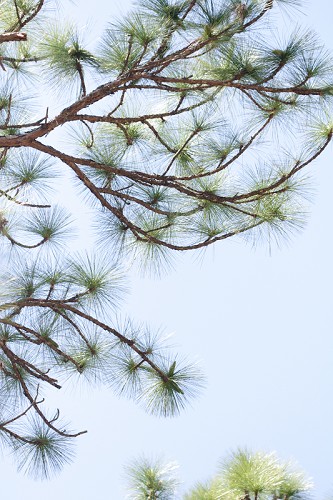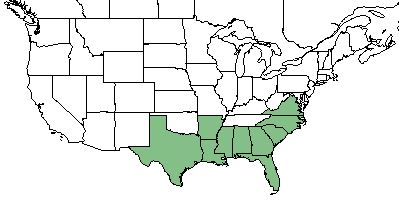Pinus palustris
Common Names: Longleaf pine[1], southern pine[2]
| Pinus palustris | |
|---|---|

| |
| Photo by John Gwaltney hosted at Southeastern Flora.com | |
| Scientific classification | |
| Kingdom: | Plantae |
| Division: | Magnoliophyta - Flowering plants |
| Class: | Magnoliopsida - Dicots |
| Order: | Pinales |
| Family: | Pinaceae |
| Genus: | Pinus |
| Species: | P. palustris |
| Binomial name | |
| Pinus palustris Mill. | |

| |
| Natural range of Pinus palustris from USDA NRCS Plants Database. | |
Contents
Taxonomic Notes
Synonym: P. australis (Michaux)[2]
Variety: none[2]
Description
Pinus palustris is a perennial tree of the Pinaceae family that is native to North America.[1]
Distribution
P. palustris is found throughout the southeastern United States; specifically in Florida, Georgia, South Carolina, North Carolina, Virginia, Alabama, Mississippi, Louisiana, Arkansas, and Texas.[1]
Ecology
Habitat
Habitat falls largely within the southeastern Atlantic coastal plain and Gulf coastal plain. They require warm, wet, and temperate climates that have a steady reliable annual precipitation of 43-69 inches. It is common in sandy, well-drained soils close to sea level.[1]
P. palustris exhibits no significant response to agricultural-based soil disturbance in North Carolina longleaf pine communities.[3]
It has shown regrowth in reestablished native longleaf habitat that was disturbed by agriculture in South Carolina, making it a post-agricultural woodland indicator species.[3]
This species reduced its crown cover and biomass in response to heavy silvilculture in north Florida pine flatwoods. It has shown resistance to regrowth in reestablished flatwoods that were disturbed by these practices.[4]
Specimens have been collected from hardwood hammocks, longleaf pine scrub oak ridge, sandy soils with many oak species, and old longleaf stands.[5]
Being historically known to the southeastern coastal plains, the longleaf pine stands have been an ideal habitat for herbaceous diversity.[6]
Pinus palustris is frequent and abundant in the Peninsula Xeric Sandhills, Panhandle Xeric Sandhills, North Florida Longleaf Woodlands, North Florida Subxeric Sandhills, Clayhill Longleaf Woodlands, Panhandle Silty Longleaf Woodlands, Xeric Flatwoods, North Florida Mesic Flatwoods, Central Florida Flatwoods/Prairies, Peninsula Savannas, North Florida Wet Flatlands, Upper Panhandle Savannas, and Lower Panhandle Savannas community types as described in Carr et al. (2010).[7]
Seed dispersal
This species is thought to be dispersed by wind.[8]
Seed bank and germination
Germination needs mineral soil and 1-2 weeks after dispersal. Most germination occurs during the fall and spring. Only after the first two years of development, seedlings will begin to develop stems and growth in height begins to occur rapidly. During the first two years, the root system is developing, preparing for a rapid growth to extreme heights.[1]
Fire ecology
P. palustris requires frequent burning for a healthy environment. Without frequent burning, hardwood species will begin to overtake the habitat. The species requires burning to regenerate and seed. P. palustris has a high fire tolerance[1] as evidenced by populations that have been known to persist through repeated annual burns.[9][10]
Herbivory and toxicology
Pinus palustris has been observed to host assassin bugs such as Zelus tetracanthus (family Reduviidae).[11] Birds and small mammals eat the large seeds, ants will eat the seeds that are germinating, and razorback hogs eat the roots of the seedlings.[1] The tree provides habitats for bobwhite quail, white tailed deer, wild turkey, and fox squirrel.[1] The red-cockaded woodpecker will use the old growth stands for nesting.[1] Hogs have been known to eat the seedlings during the initial stages of development.[1]
Diseases and parasites
The brown spot needle disease can cause defoliation of the P. palustris tree. It is a fungus that occurs with a build up of dead grass on the forest floor and can spread to the young trees and seedlings. Frequent burning can reduce the likelihood of this disease spreading.[1]
Conservation, cultivation, and restoration
Frequent fire is necessary to maintain a healthy forest of P. palustris. They grow in the place of dead trees, allowing for many tree of the same age to disperse to the same area where old trees have fallen.[1]
Excessive grazing of the forest floor will reduce the P. palustris in the region.[1]
Pinus palustris stands have been declining since European settlement with an increase in logging, agricultural conversion, and suppressing natural fires that are key to the health of long-leaf pine land.[12] They were once considered the most abundant ecosystem in North America with over 37 million ha to only 1.5 ha in 1985.[13]
P. palustris is ideal for reforestation in the proper climates; dry, seep sands in the southeastern United States.[1]
Longleaf trees that were injured by anthropogenic activity will develop fire scars, where they were cut or sliced, after a burn. These can indicate when the region expereinced natural or prescribed burning.[14]
Soil disturbances such as soil compaction, surface scarring, and most sifgnificantly agricultural disturbances have a large impact on the longleaf pine composition in a region.[15]
Cultural use
Oil from this tree has been used in the past to treat colic, chronic intestinal problems, and as a clotting agent for injuries. The gum can be used for tuberculosis, kidney issues, and for menstrual regulation.[16]
Photo Gallery
References and notes
- ↑ 1.00 1.01 1.02 1.03 1.04 1.05 1.06 1.07 1.08 1.09 1.10 1.11 1.12 1.13 USDA Plant Database
- ↑ 2.0 2.1 2.2 Weakley, A.S. 2020. Flora of the Southeastern United States. Edition of 20 October 2020. University of North Carolina at Chapel Hill, Chapel Hill, North Carolina.
- ↑ 3.0 3.1 Brudvig, L.A., J.L. Orrock, E.I. Damschen, C.D. Collins, P.G. Hahn, W.B. Mattingly, J.W. Veldman, and J.L. Walker. (2014). Land-Use History and Contemporary Management Inform an Ecological Reference Model for Longleaf Pine Woodland Understory Plant Communities. PLoS ONE 9(1): e86604.
- ↑ Conde, L.F., B.F. Swindel, and J.E. Smith. (1986). Five Years of Vegetation Changes Following Conversion of Pine Flatwoods to Pinus elliottii Plantations. Forest Ecology and Management 15(4):295-300.
- ↑ URL: http://herbarium.bio.fsu.edu. Last accessed: June 2018. Collectors: Loran C. Anderson, R.K. Godfrey, Cecil R. Slaughter, Kurt Blum, S.W. Leonard, A. S. Jensen, S. L. Beckwith, Sidney McDaniel, S. Snedaker, D. B. Ward, Patricia Elliot, L. B. Trott, J. P. Gillespie, R. Komarek, Leon Neel, K. M. Meyer, A. Townesmith, Annie Schmidt States and counties: Florida (Franklin, Leon, Putnam, Washington, Orange, Citrus, Nassau, Marion, Wakulla, Liberty) Georgia (Harris)
- ↑ Andreu, M. G., et al. (2009). "Can managers bank on seed banks when restoring Pinus taeda L. plantations in Southwest Georgia?" Restoration Ecology 17: 586-596.
- ↑ Carr, S.C., K.M. Robertson, and R.K. Peet. 2010. A vegetation classification of fire-dependent pinelands of Florida. Castanea 75:153-189.
- ↑ Kirkman, L. Katherine. Unpublished database of seed dispersal mode of plants found in Coastal Plain longleaf pine-grasslands of the Jones Ecological Research Center, Georgia.
- ↑ Robertson, K.M. Unpublished data collected from Pebble Hill Fire Plots, Pebble Hill Plantation, Thomasville, Georgia.
- ↑ Platt, W.J., R. Carter, G. Nelson, W. Baker, S. Hermann, J. Kane, L. Anderson, M. Smith, K. Robertson. 2021. Unpublished species list of Wade Tract old-growth longleaf pine savanna, Thomasville, Georgia.
- ↑ Discoverlife.org [1]
- ↑ Aschenbach, T. A., et al. (2010). "The initial phase of a longleaf pine-wiregrass savanna restoration: species establishment and community responses." Restoration Ecology 18(5): 762-771.
- ↑ Brockway, D. G. and C. E. Lewis (1997). "Long-term effects of dormant-season prescribed fire on plant community diversity, structure and productivity in a longleaf pine wiregrass ecosystem." Forest Ecology and Management 96: 167-183.
- ↑ Huffman, J. M. and M. T. Rother (2017). "Dendrochronological field methods for fire history in pine ecosystems of the southeastern coastal plain." Tree-Ring Research 73(1): 42-46.
- ↑ Ostertag, T. E. and K. M. Robertson (2007). A comparison of native versus old-field vegetation in upland pinelands managed with frequent fire, south Georgia, USA. Proceedings of the 23rd Tall Timbers Fire Ecology Conference: Fire in Grassland and Shrubland Ecosystems, Tallahassee, Tall Timbers Research Station.
- ↑ Korchmal, Arnold & Connie. 1973. A Guide to the Medicinal Plants of the United States. The New York Times Book Company, New York.